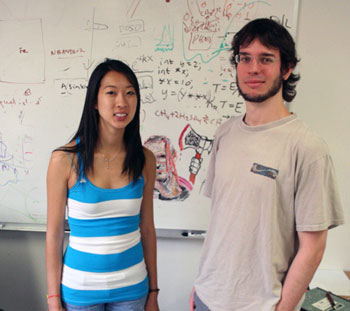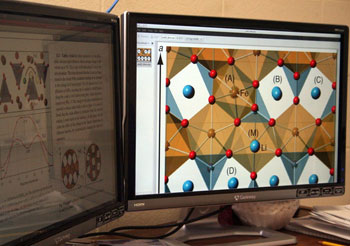Chemistry professor and undergraduates research platinum-based fuel cells with advanced computing technologies through the Freshman Research Initiative.
 Kelly Tran and Matt Welborn, undergraduate research assistants and FRI alumni.Platinum-based fuel cells offer an attractive alternative to internal combustion engines as a future means of utilizing chemical engergy.
Kelly Tran and Matt Welborn, undergraduate research assistants and FRI alumni.Platinum-based fuel cells offer an attractive alternative to internal combustion engines as a future means of utilizing chemical engergy.
There are, however, shortcomings of such technologies that must be resolved if they are to become practical and widespread. Some of these difficulties include the short lifetime of electrodes in acidic environments, an energy loss due to slow oxygen reduction, the high material cost and the limited supply of platinum itself, according to Graeme Henkelman, professor of chemistry at The University of Texas at Austin.
The interesting case of gold suggests a possible alternative. When gold clusters on the scale of a few nanometers, it becomes a very good catalyst for the oxidation of carbon monoxide. But even small amounts of gold are still expensive and not as effective for oxygen reduction, so students in the Freshman Research Initiative (FRI) are seeking more efficient alternatives by looking at other cheaper metals such as silver, nickel and copper.
FRI is a program in the College of Natural Sciences at The University of Texas at Austin that allows freshmen to take part in cutting-edge research in chemistry, biochemistry, nanotechnology, molecular biology, physics, astronomy and computer sciences. Students who enjoy and make progress in their research have the opportunity to continue in the summer and throughout their undergraduate program.
Kelly Tran and Matt Welborn both participated in the program in their freshmen year and now investigate nanoparticles under Henkelman’s guidance. They are among an elite group of undergraduates in the U.S. who have access to the supercomputers of the National Science Foundation’s (NSF) TeraGrid for research.
 A simulation of an olivine phosphate, a material used as cathode in Li ion batteries.When one thinks of chemical reactions, one usually imagines beakers and test tubes. However, Henkelman’s researchers use computational chemistry, where the reactions occur “virtually” on the silicon chips of powerful computers. The Ranger and Lonestar supercomputers at the Texas Advanced Computing Center have been critical in helping to find potential candidates to replace platinum. Using these massive computing systems, calculations of nanoparticle properties are completed at a faster rate with many jobs processed at the same time.
A simulation of an olivine phosphate, a material used as cathode in Li ion batteries.When one thinks of chemical reactions, one usually imagines beakers and test tubes. However, Henkelman’s researchers use computational chemistry, where the reactions occur “virtually” on the silicon chips of powerful computers. The Ranger and Lonestar supercomputers at the Texas Advanced Computing Center have been critical in helping to find potential candidates to replace platinum. Using these massive computing systems, calculations of nanoparticle properties are completed at a faster rate with many jobs processed at the same time.
The Henkelman Research Group is trying to understand the relationships between the structure of nanoparticles and their catalytic activity in order to design new materials tailored to catalyze a particular reaction. The discovery of catalytic gold is inspiring, because it suggests that there could be new classes of nanoscale catalysts. The group is focusing on the development of non-platinum metal nanoparticles designed to catalyze the oxygen reduction reaction (ORR). Cheap ORR catalysts would be instrumental for next-generation fuel cells and the development of efficient alternative energies sources.
The issue, however, is somewhat of a goldilocks dilemma. The search for a cheaper, yet still effective catalyst depends on the binding energy of molecules, such as oxygen, to the nanoparticles. The binding energy can be neither too weak, nor too strong. In both limits, the reaction is slowed by large energy barriers in the reaction path.
 Kelly Tran looking at binding of p-nitrophenol to a copper/platinum slab.Tran, a senior chemistry major and undergraduate research assistant for FRI, is currently exploring methods of separating ethylene from ethane and propylene from propane through nanocomposite membranes. Working with Zachary Pozun, a graduate research assistant in the Henkelman Group, Tran has also been investigating the binding of ethylene to different metals of different sizes and compositions.
Kelly Tran looking at binding of p-nitrophenol to a copper/platinum slab.Tran, a senior chemistry major and undergraduate research assistant for FRI, is currently exploring methods of separating ethylene from ethane and propylene from propane through nanocomposite membranes. Working with Zachary Pozun, a graduate research assistant in the Henkelman Group, Tran has also been investigating the binding of ethylene to different metals of different sizes and compositions.
“The computer simulations allow us tight control factors, so we can ask questions like, ‘How do the properties of a metal on the surface of a core/shell particle change by replacing the core?” said Pozun.
FRI researchers in the computational nanoparticles stream are able to work anywhere as long as there is internet access. “What makes this stream special is that we can work on campus or at home as long as we're able to log onto the supercomputer,” said Tran. “More than 75 percent of our research is done remotely on Ranger and Lonestar.”
Running calculations on Ranger and Lonestar introduces another valuable aspect of FRI. During the three-semester program, students are taught how to conduct independent research while receiving mentorship from graduate students and professors. After learning the computation skills needed, Tran began researching her own project. Currently, she is working on understanding nitrophenol reduction at nanoparticles and mentoring freshman in a lower division lab.
Welborn joined the computational nanotechnology stream in his sophomore year, which eventually led him to change his postgraduate career goals from pre-med to scientific research. Welborn, a dean’s honor student, had no background in research but received encouragement from the program and has made impactful discoveries. He has been working on combining experimental X-ray diffraction data and information about the electronic structure of platinum nanoparticles. Knowing about the disorder at the surface, Wellborn says, is critical for understanding reactions that are key to the success of hydrogen fuel cells.
Students in the FRI program have achieved national recognition. The University of Texas at Austin was recently represented at the Undergraduate Research Day at the Capitol in February with FRI alumnus Matt Welborn, who presented his work with Graeme Henkelman of the Computational Nanoparticles stream. Welborn was also recently awarded a prestigious NSF graduate fellowship, which will support his work in this area as he goes to graduate school next year. Pozun and Tran, along with Anna Shi and Ryan Smith, also students in FRI, published a paper titled “Why Silver is Effective for Olefin/Paraffin Separations.” The group presented their findings at the American Chemical Society in 2010.
“The FRI program helps young students experience what it is to do research,” Henkelman said. “And if they like it, it gives them the resources they need to excel.”
Written by: Mourin Nizam
Science and Technology Writer


















Comments 2
I cogitate this is a actual outstanding article flier.Thanks Again. Truly Large.
F*ckin' awesome things here. I am very satisfied to peer your article. Thanks so much and i'm taking a look forward to contact you. Will you kindly drop me a e-mail?